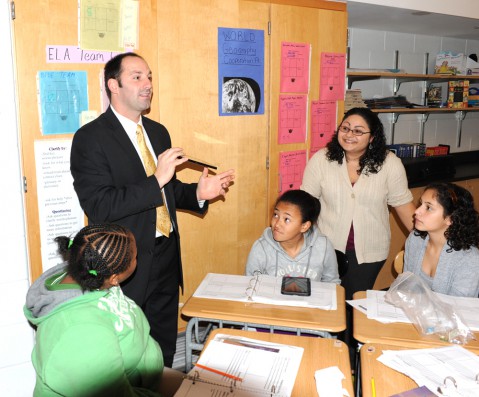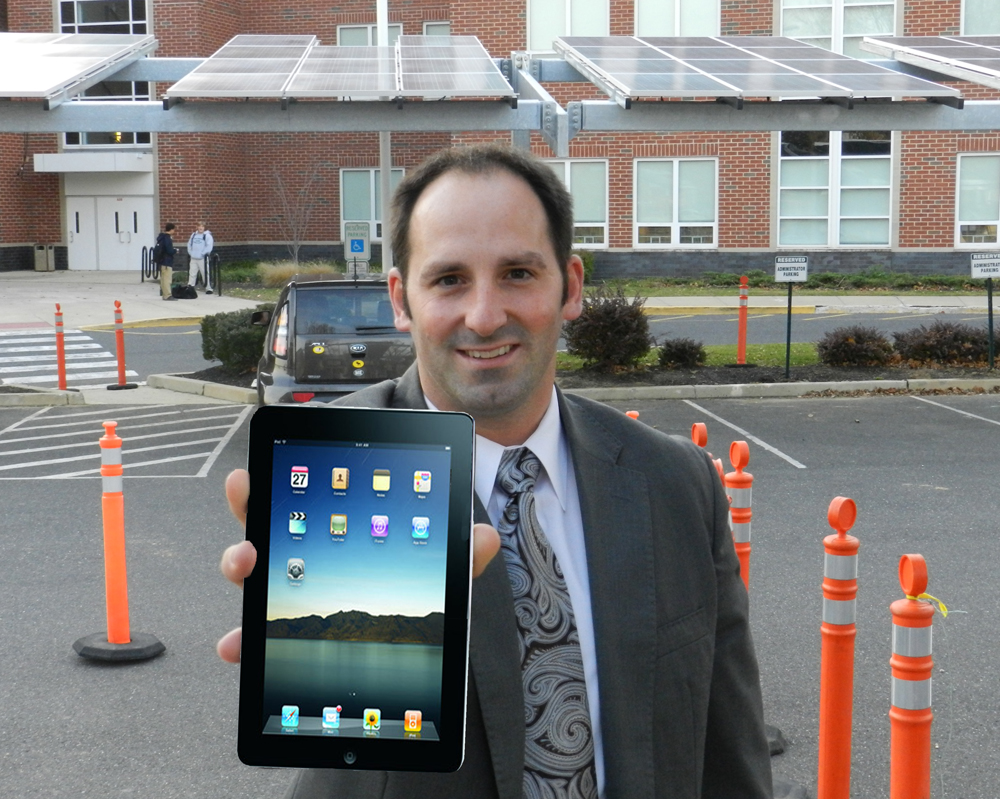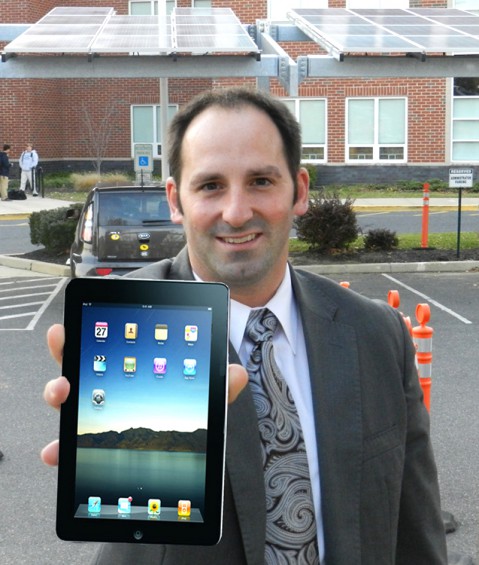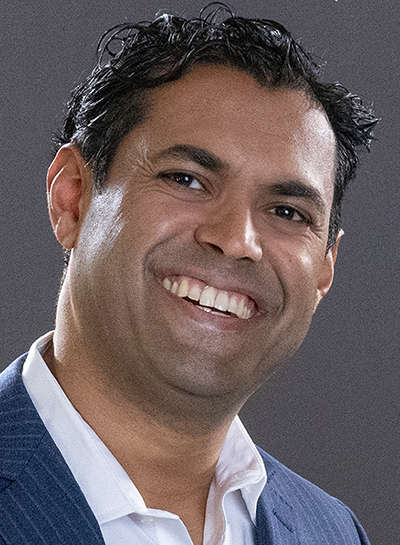More politicians back ‘racinos’ and voters agree
November 11, 2011
City reflects on origins of Veterans Day, and needs of troops today
November 18, 2011
Long Branch Schools Superintendent Michael Salvatore explains to Victoria Ferrara’s middle school students how the tablet will work for them.
By Patty Booth O’Neill
Long Branch – Michael Salvatore, Superintendent of Schools, can’t hide his excitement about the district’s latest projects. By January every public school in the city will be powered by solar energy and every child from third grade to 12th will have a hand-held 3G Samsung Galaxy tablet to take home.
“Both of these initiatives are the future,” said Salvatore, who rattled off figures about the projects. Before the board of education approved the installation of solar panels, an intense energy audit was performed (paid for by a grant).
The auditors began with the easiest advice on how to save energy, basically reducing consumption, to the most complicated being wind and solar energy.
One of the first steps undertaken in the district was placing light sensors in every room. If there is no movement detected within 15 minutes, the lights automatically turn off. “That in itself saves a lot of money,” Salvatore said. “From there we had to make a decision on solar or wind power.”
Wind power, according to the experts, was not cost-effective and would not generate as much energy as solar. Windmills need a lot of space, where solar panels could be installed on existing structures.
One of the benefits of the solar project is that it creates renewable energy credits that the district can store and sell back to the energy company at a later date. “Today it might be worth $1 a kilowatt hour, next year it might be worth $3. When the price goes up we can sell back the stored energy at a profit, while we have already cut down on our total energy cost,” said Salvatore.
Solar panels and solar canopies are being installed throughout the district. As of today only one school — Gregory — is fully up and functional.
A study done at Gregory School showed that there was a $2,000 reduction in the electrical bill in one month alone.
“Gregory School is a small site with just a few solar panels, but when I saw the savings, I couldn’t believe it,” Salvatore said.
When all the schools are up and functional, there is an anticipated savings between 10-12 million dollars over ten years.
The board of education approved the $10 million dollar project, invested $1 million of its own money, and expects to pay off the project in five to six years.
“We’re fortunate to have a budget to explore these types of projects,” Salvatore said. “It’s an investment, but the profit does come back into the district, and we are talking about decades of savings.”
Solar is just one step in the Green Wave’s desire to go green and efficient. Salvatore has his staff evaluating cleaning supplies and chemicals that have been used in the past. During the summer, he explained, schools had a distinctive smell of chemical strippers and wax. “We found out that by using a microfiber pad we can eliminate the need for chemicals,” said Salvatore. The process takes much less time and no chemicals. “So we are looking at everything on how to be effective and responsible to the taxpayers of Long Branch for now and decades to come.”
As enthused as Salvatore is about going green, his excitement over the Galaxy Tablets is even more evident. “For the past few years we have purchased laptop computers for all fifth graders,” said Salvatore. The concept was that the laptops would follow students from fifth to twelfth grade. However sometimes computers were not cooperative. It took time to start them up, sometimes programs don’t respond and not all students had access to broadband internet service.
ConnectedNation, a high-speed internet access advocacy group, conducted a national survey that revealed that out of 17 million U.S. children without broadband, 7.6 million of these are in low-income households.
The lack of high-speed internet access means no Google, no Wikipedia, no social networking and no personalized learning. It also means that your chances of graduating from high school and finding a job are slim, according to the study.
It is creating what ConnectedNation is calling “Internet Underclass” and impoverished and disconnected population with fewer educational and employment opportunities.
That’s exactly the same problems students face in Long Branch. It’s estimated that around 40 percent of Long Branch’s low income families don’t have broadband access and some don’t have computers at all. “So the district would give a student a laptop, but unless they had internet access at home, it was just a flat typewriter.” Salvatore said.
This year Salvatore decided the did not want to purchase anymore laptops. “I told my business administrator that I wanted our students to have a tablet. They are portals to the internet and we can purchase five or six for the price of one laptop,” he said.
Verizon was contacted and the company met with Salvatore and his cabinet offering several devices for him to look at. He was asked to test drive each of the devices and found that the Galaxy Tablet was the best.
When he met with Verizon executives a second time, he told them he wanted to order one for each middle school student.
The company was so impressed they donated an additional 1,000 tablets. “Now we can provide a tablet to every student from fifth to twelfth grade,” said Salvatore.
However, he still had the issue of connectivity. Most plans run $40 a month for data usage. Salvatore was able to negotiate with Verizon and get that amount down to $6 a month for all Long Branch students. The district was able to use E-Rate, a federal program, to pay for the monthly access charge.
A comprehensive educational plan was established. Verizon is loading all the devices with applications required by the district. Each is also loaded with a GPS chip, so if it’s lost or stolen Verizon knows exactly where it is. A third party hired by Verizon will locate the device. If they can’t recover it, it’s wiped clean and rendered useless by Verizon. “I see these tablets as a way to extend the school day for every child by two hours,” said an excited Salvatore.
He feels students will be excited to learn and will be able to advance at their own level. “Eventually these pocket-sized devices will replace text books.”
“My students and I are so excited to be implementing tablets in our instruction,” said middle school teacher Victoria Ferrara. “The tablet is an engaging and educational tool that students will be able to use at school, home or on the go.
Mr. Salvatore and the board of education are supplying our students with a wonderful opportunity to advance their learning and access to the ever-changing world of technology, all in a swipe or tap of a screen.”
“I am so excited for what we’re getting,” said Quincy Southerland, a middle school student. “It will be like the phone I never got, but it will help me learn.”
That is exactly what Salvatore has in mind. He wants to engage students and get them excited about learning using the latest technology.
“I think it is cool that we get to use the tablet. It will make school and learning more fun,” said Javon Crawford, also a middle school student. His classmate Diamond Washington was also excited about the tablet and said it will improve her grades as she will be able to do homework all the time now.
Since Salvatore took over the district in April, he has been focused on curriculum and standards. He has implemented many new programs from writing to vocabulary, all in an effort to improve student’s performances.
“As superintendent I make every decision based on how it will help or impact students. I need to have the best teachers and provide them with the tools they need to be successful,” he said.
One computer software programs the district has initiated allows teachers to monitor what homework a student is doing, how much time they’re spending on it and what issues they are having. “It allows teachers to see if they need to re-address a topic or change the way they deliver the subject matter,” said Salvatore.
The software also tells a student when they get the problem wrong, and shows them how to think it out and helps correct them along the way.
“We have been able to extend a students’ day and can now get the entire family involved. I picture mom driving her child to a soccer game saying ‘get out your tablet and do your homework.”’
To see how much energy the solar panels at Gregory School are generating in real time go to http://rai.kiosk-view.com/gregory and click on facilities.






